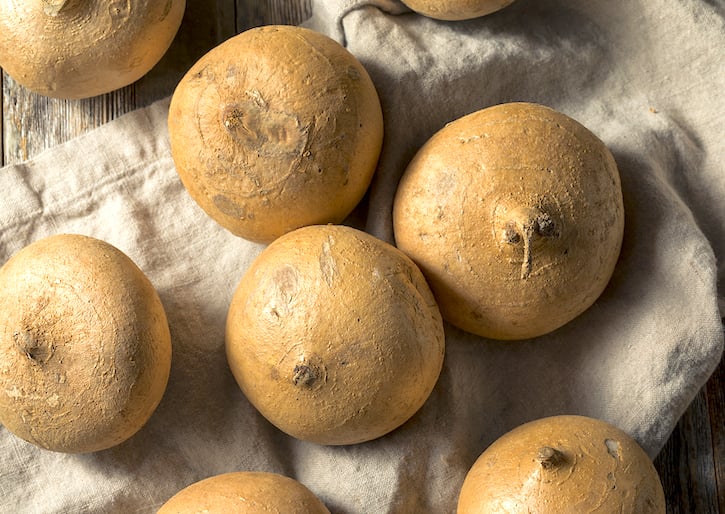This concise guide to jícama has tips on how to prep and use this tasty tuber vegetable that’s most commonly available in the fall. Find easy ideas as well as links to lightly cooked and raw jícama recipes, too.

While its unique qualities are best showcased by using it raw, jícama can also be sautéed, stir-fried, and roasted. If it’s nice and fresh, the flesh is juicy, with a texture that’s can be described as a cross between apple, turnip (or radish), and water chestnut.
What is jícama?
Native to Latin America, jícama is a tuber with a slightly sweet flavor that makes it compatible with both vegetables and fruits in various dishes.
Shaped like a large turnip with a thin, rough tan skin (which should be peeled before using), it lends itself to lots of preparations.
Jícama is pronounced HIK-ka-ma. It has variously been called Mexican potato, yam bean, Mexican turnip, and other quaint names rarely used any longer.

The following information is excerpted and adapted from Melissa’s Great Book of Produce: Everything You Need to Know About Fresh Fruits and Vegetables by Cathy Thomas ©2006, reprinted by permission of Melissa’s Produce.

Because jícama is mildly sweet, it can be a surprising addition
to fruit salads or cut fruit platters.
How to store jícama
In its true season (the fall months) you can find jícama in supermarkets, natural foods stores, farm markets, and ethnic groceries.
Small or medium-size jícamas are often the best; large, thick-skinned jicamas can be dry and fibrous. Avoid those with cracks or shriveling.
Store whole jícama in a cool location (ideally the vegetable crisper drawer in your refrigerator), unwrapped, for up to 3 weeks. Once cut, cover tightly with plastic wrap and refrigerate; use within one week at most.

How to prep jícama
Trim away the knobby top and bottom of the vegetable. The easiest way is to peel is to first cut the jícama into 1/2-inch-thick rounds or half-rounds. Cut the peel away with a paring knife.
Cut into desired shape: cubes, slices, or sticks. Seal any any unused portion tightly in plastic wrap to prevent drying, and refrigerate.
Nutrition info
Jícama is low in calories, has almost zero fat, and is a good source of fiver. An excellent source of vitamin C, it also provides modest amounts of iron, magnesium, copper, and other minerals. See more about its nutritional profile.

Jícama fries are a tasty, lower-carb swap-in for potatoes.
See a recipe further down.
Easy ways to use jícama
Water chestnut substitute: Swap in for water chestnuts in Asian salads and stir-fries. Jicama retains crunchiness even when cooked for several minutes.
Roasted vegetable medleys: Add bite-sized slices to any combination of roasted vegetables, baked in a 425º oven. Try adding some to Balsamic and Maple Roasted Vegetables.
Chile-lime snack: Cut peeled jícama into sticks. Top with freshly squeezed lime juice and sprinkle with chile powder and salt.
Colorful appetizer: Cut peeled jicama into thin slices; if large, cut into quarters. Top each with small spoonful of fruit salsa, such as mango salsa.
Taco or tostada garnish: Toss peeled, diced jicama with lime juice, chopped cilantro, chile powder, salt, and pepper. Add diced cooked carrots or finely shredded red cabbage, if desired. Use as part of filling or topping for tacos and tostadas.
Crunchy Slaw: Add a cup or so of grated jícama to your favorite coleslaw recipe.
Grill it: Brush 1/2-inch-thick slices lightly with olive oil and cook on a hot grill or grill pan, 3 minutes or so per side or until you get those nice grill marks.
Jícama recipes
With thanks to the bloggers who contributed photos of their recipes and links to them for the following round-up.

Jícama Fries: From Running to the Kitchen, these thin cut jicama fries bake up easily in the oven with the perfect crispy fry texture. Enjoy this healthier take on fries that’s high in fiber, lower carb and gluten-free friendly with your favorite dipping sauce.

Popiah (Malaysian Spring Rolls): From My Plantiful Cooking, these tasty spring rolls, or popiah, are a popular Malaysian delicacy. Filled with jícama, bean sprouts, and tofu, they’re fresh, flavorsome and tasty as well as easy to make.

Avocado and Jícama Salad with Blueberries & Roasted Corn: Avocado and jícama salad has become a summer classic. Embellished with blueberries and roasted corn kernels, it adds a splash of color to the plate.

Jícama Salad with Oranges and Herbs: A tasty cool-weather dish using two classic fall vegetables, this jícama and fennel salad gets a lovely citrus lilt from fresh oranges and lime dressing.

Jicama Mango Salad: From Running to the Kitchen, this light and crunchy jicama salad is a wonderfully refreshing summer dish. Vegans, simply replace the honey in the dressing with maple syrup or agave.

Jicama and mango or papaya salad: Another idea that needs no recipe. Combine an equal amount of coarsely grated or matchstick-cut jícama with slightly underripe mango or papaya, cut to match. Flavor with a little orange juice and orange zest, olive oil, cider or wine vinegar, and salt and pepper to taste.

Pineapple Jicama Salsa: From It’s a Veg World, this refreshing jicama salsa recipe pairs crunchy jicama and juicy pineapple with bell peppers, red onion, jalapeno, cilantro, and lime. It’s a delicious vegan snack that can be enjoyed with tortilla chips and on tacos.
See more of this site’s Good Food Guides.

Text adapted from Melissa’s Great Book of Produce
(available wherever books are sold)

Leave a Reply